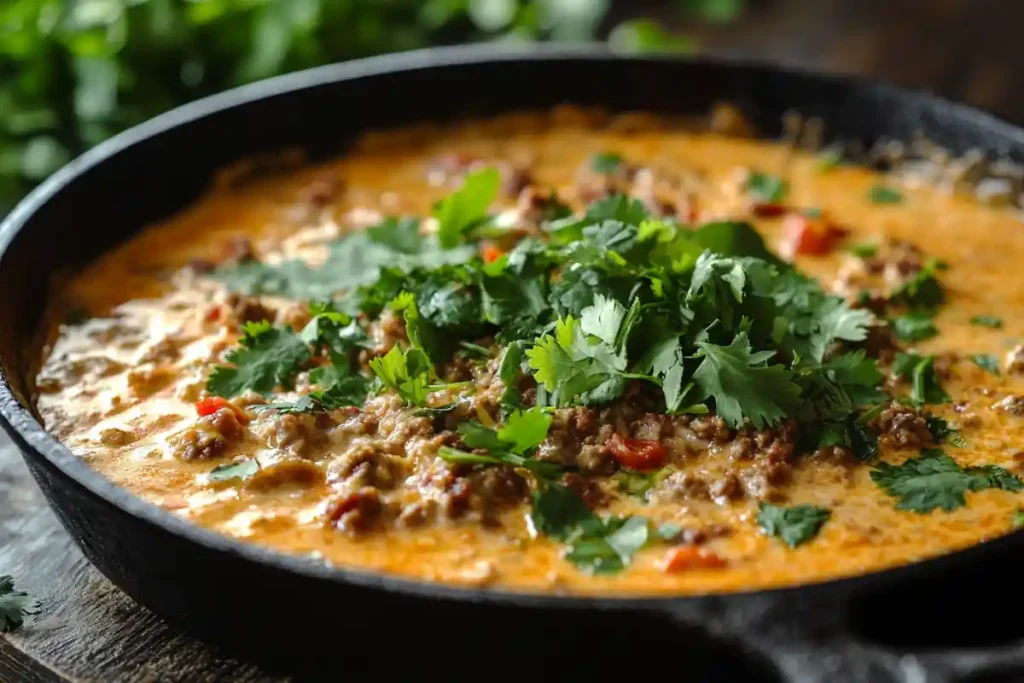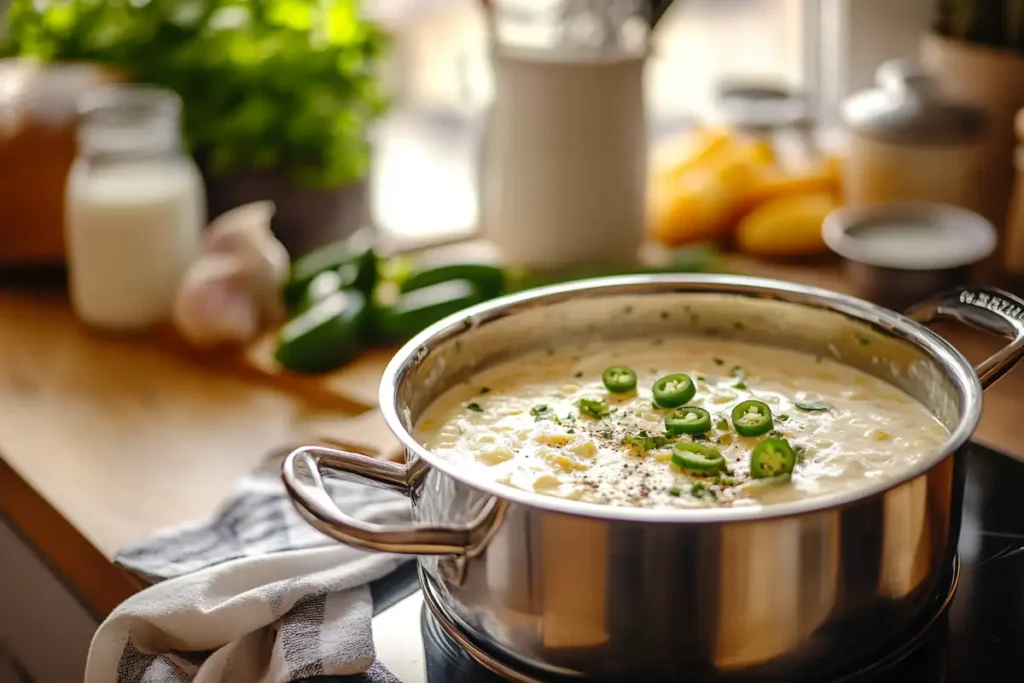Queso, a beloved cheesy dish, often sparks a tantalizing question: Is queso just melted cheese? While its creamy allure is undeniable, the answer isn’t as simple as it seems. From its origins in Mexican cuisine to its evolution as a Tex-Mex staple, queso encompasses a world of flavors and techniques that go far beyond merely melting cheese. In this article, we’ll uncover what makes queso truly unique, explore its cultural significance, and even guide you on how to make it yourself. Get ready to savor the fascinating story of queso—one delicious bite at a time.
Introduction and Defining Queso
A Love Letter to Queso
Few foods have the universal appeal of queso. Whether it’s served as a warm, gooey dip at a party or bubbling in a skillet at a family dinner, queso has a way of bringing people together. But what exactly is it? Is it simply cheese, or does it have its own identity? Let’s dive into the heart of this dish to uncover its essence and why it holds such an esteemed place in our culinary culture.
What is Queso?
The word queso directly translates to “cheese” in Spanish, but when you hear someone talk about “queso” in a food context, it typically refers to much more. In Mexican cuisine, queso often means queso fundido, a dish of melted cheese served hot, often with chorizo or vegetables. On the other hand, Tex-Mex cuisine interprets queso as a creamy dip, frequently made with processed cheeses like Velveeta and spiced up with jalapeños, tomatoes, or chili.
Queso is more than its components. It’s a dish that has crossed cultural and geographical boundaries, adapting to local tastes and ingredients. While authentic Mexican queso fundido highlights traditional cheeses like Asadero or Oaxaca, Tex-Mex queso embraces a modern, convenience-driven approach. Both versions, however, share a common goal: delivering a rich, cheesy experience.
Why Queso is Not Just Melted Cheese
At first glance, queso might look like melted cheese, but the magic lies in the preparation and the blend of ingredients. Melted cheese on its own tends to harden as it cools, but queso, especially the Tex-Mex version, stays creamy and smooth. How? This is thanks to additional elements like milk, cream, and emulsifiers, which create that signature silky texture. These ingredients transform queso into something entirely different, ensuring it’s not just melted cheese, but a dish in its own right.
From its rich history to its mouthwatering versatility, queso is a culinary treasure that has enchanted food lovers worldwide. As we continue, we’ll explore its intricate components and guide you through the delicious journey of making and enjoying this iconic dish.
The Composition of Queso
Queso vs. Melted Cheese
So, is queso just melted cheese? The short answer: not exactly. Melted cheese alone is a simple result of heat softening its structure, but queso is a fusion of flavors and textures that elevate it to a dish all its own. While melted cheese hardens as it cools, queso dip remains creamy, luscious, and perfect for dipping, even after sitting out for a while. This difference boils down to the ingredients and techniques used.
In Mexican queso fundido, the cheese is melted in a way that preserves its stretchiness and flavor. It’s often paired with toppings like sautéed peppers or seasoned meats, making it hearty and flavorful. On the other hand, Tex-Mex queso incorporates processed cheeses like Velveeta or American cheese, which are engineered to melt seamlessly, and often blends in milk or cream to achieve a velvety consistency.
Types of Cheese Used in Queso
The type of cheese you choose can make or break your queso. Authentic Mexican varieties like Oaxaca, Chihuahua, and Asadero are perfect for queso fundido, as they melt beautifully while retaining a mild, buttery flavor. These cheeses have a slightly elastic quality, which gives the dish a delightful pull when served hot.
For Tex-Mex-style queso, cheddar is a common choice due to its sharp, tangy flavor. Processed cheeses, such as Velveeta or American cheese, are also popular because of their emulsified properties, which keep the dip smooth and creamy. Want to experiment? Mix and match cheeses like Monterey Jack or Pepper Jack to add complexity and heat to your queso.
Cultural Variations of Queso

The beauty of queso lies in its adaptability across cultures. In Mexico, queso fundido is celebrated as a standalone dish. Served bubbling hot in a cast-iron skillet, it’s typically eaten with warm tortillas or bread. The addition of earthy ingredients like mushrooms, poblano peppers, or smoky chorizo elevates the dish into a hearty, satisfying appetizer.
Meanwhile, Tex-Mex queso takes a more casual approach, appealing to crowds at game nights or parties. This version is often served as a dip alongside tortilla chips. Sometimes, diced tomatoes, green chilies, or even guacamole are stirred in for extra flavor. Both versions are equally cherished, but their unique preparations and presentations showcase the culinary diversity of queso.
Queso is far more than its basic ingredients—it’s a symbol of creativity in the kitchen, a dish that evolves with every culture it touches.
Making Queso at Home
How to Make Authentic Queso

Creating authentic queso at home is easier than you might think! Let’s start with the Mexican classic, queso fundido. This dish relies on high-quality, meltable cheeses and simple ingredients to deliver a rich, authentic flavor. Here’s a basic recipe:
Ingredients:
- 2 cups of grated Oaxaca or Chihuahua cheese (or a mix)
- 1 tablespoon of olive oil
- ½ cup of diced poblano peppers or jalapeños
- ½ cup of cooked chorizo or sautéed mushrooms (optional)
- Warm tortillas for serving
Instructions:
- Preheat your oven to 375°F (190°C).
- Heat a cast-iron skillet on medium heat, adding olive oil. Sauté the peppers until soft. If using chorizo, cook it alongside the peppers.
- Reduce the heat, layer the grated cheese evenly in the skillet, and transfer it to the oven.
- Bake until the cheese is fully melted and bubbly, about 10 minutes.
- Serve hot with tortillas or crusty bread for dipping.
This version of queso highlights the stretchy texture and robust flavor of authentic Mexican cheeses, offering a traditional experience that’s hard to beat.
Common Variations of Queso Recipes
If you’re leaning toward the Tex-Mex side of things, making a creamy queso dip is the way to go. Here’s a quick recipe for the popular version:
Ingredients:
- 1 block (16 oz) of Velveeta cheese, cubed
- 1 can (10 oz) of diced tomatoes with green chilies
- ½ cup of whole milk
- Optional: ¼ cup of diced onions or cooked ground beef
Instructions:
- Combine the Velveeta cheese, diced tomatoes, and milk in a medium saucepan.
- Heat over medium-low heat, stirring frequently, until the cheese melts into a smooth sauce.
- Add optional mix-ins like onions or ground beef for extra flavor.
- Serve immediately with tortilla chips.
For those who prefer plant-based options, vegan queso is a delightful alternative. Made with ingredients like cashews, nutritional yeast, and roasted red peppers, it offers a creamy, dairy-free twist.
Tips for Perfecting Your Queso
No matter which recipe you choose, follow these tips for the best results:
- Use freshly grated cheese: Pre-shredded cheeses often contain anti-caking agents that can affect melting.
- Keep the heat low: High heat can cause the cheese to separate and become grainy.
- Add liquid gradually: Whether it’s milk, cream, or plant-based options, incorporating liquid slowly helps maintain a smooth texture.
Making queso at home is all about tailoring it to your taste. Whether you stick to traditional queso fundido or venture into Tex-Mex territory, there’s no wrong way to enjoy this cheesy classic. Coming up, we’ll unravel the science that makes queso so irresistibly creamy!
The Science Behind Queso
Why Does Cheese Melt?
The magic of melted cheese lies in its molecular structure. Cheese is made up of proteins, fats, and water, which interact uniquely when heated. When exposed to heat, the fat in the cheese softens, and the protein network loosens, allowing the cheese to melt. However, not all cheeses melt the same way.
Soft cheeses like mozzarella or Oaxaca are high in moisture, which makes them melt quickly and evenly. Harder, aged cheeses, like Parmesan, are low in moisture and tend to melt unevenly, often separating into oil and solids. This is why the choice of cheese is crucial for making the perfect queso.
Interestingly, processed cheeses like Velveeta are engineered for melting. They contain stabilizers and emulsifiers, which help maintain a smooth and creamy texture even when heated—a hallmark of Tex-Mex queso dip.
How Ingredients Affect Queso’s Texture
The texture of queso depends on more than just the type of cheese. Additional ingredients play a vital role in achieving that creamy consistency we all love. Here’s how some common ingredients influence the outcome:
- Milk or Cream: These liquids dilute the cheese, making the queso less dense and more dip-like. They also help prevent clumping.
- Acidic Ingredients: A dash of lime juice or vinegar can break down the proteins in cheese, enhancing its smoothness.
- Stabilizers and Emulsifiers: Ingredients like sodium citrate or cornstarch prevent the fats and proteins from separating, ensuring the queso stays silky rather than greasy.
The science here is straightforward: By controlling the balance of fat, water, and emulsifying agents, you can create a queso that stays smooth and creamy for hours.
Troubleshooting Queso Issues
Even with the best ingredients, queso can sometimes go awry. Here are some common problems and how to fix them:
- Clumpy Queso: This usually happens when the cheese overheats or isn’t evenly mixed. Solution: Lower the heat and stir constantly while adding liquid to smooth it out.
- Greasy Texture: If the cheese separates, it’s often due to excess heat or the wrong type of cheese. Solution: Incorporate a stabilizer like cornstarch or sodium citrate to bring it back together.
- Runny Consistency: Too much liquid can make queso watery. Solution: Thicken it by simmering and stirring until it reaches the desired texture.
Understanding the science of queso transforms it from a simple dish into a culinary experiment. Up next, let’s explore the cultural and social significance that has made queso a staple in kitchens and gatherings worldwide!
Cultural and Social Significance of Queso
Queso in Social Gatherings

It’s no exaggeration to say that queso is the life of the party. Whether it’s game day, a family barbecue, or a casual gathering, queso consistently takes center stage as a crowd-pleasing appetizer. Its universal appeal lies in its creamy texture, rich flavor, and versatility—it pairs perfectly with tortilla chips, fresh veggies, and even pretzels.
In many ways, queso serves as a symbol of togetherness. Picture this: a warm bowl of queso dip surrounded by friends and family, everyone digging in, laughing, and enjoying the moment. It’s not just food; it’s a shared experience that transcends cultural boundaries. Plus, its ability to adapt to various dietary needs, such as vegan or gluten-free variations, ensures everyone can partake.
The Rise of Queso in Popular Culture
In recent years, queso has cemented its place as a cultural icon, particularly in North America. Fast-food giants like Chipotle and Qdoba have popularized queso by adding it to their menus, offering it as a topping or side for burritos, bowls, and tacos. The Tex-Mex variation of queso, with its smooth, processed cheese base, has become synonymous with casual dining and party food.
Interestingly, queso has also gained traction as a trendy item among foodies, inspiring chefs to reinvent it with gourmet twists. From smoked gouda queso to truffle-infused varieties, upscale versions of queso have begun appearing on restaurant menus. This evolution showcases how a humble dish can adapt to modern tastes while retaining its roots.
Beyond its presence in restaurants, queso has made its way into pop culture. Social media platforms abound with queso recipes, hacks, and reviews, further fueling its popularity. The simplicity of queso combined with its potential for creativity has made it a dish that resonates with people from all walks of life.
Queso’s cultural impact extends far beyond its deliciousness—it’s a symbol of celebration, creativity, and connection. As we near the end of our journey, we’ll wrap things up with a recap of everything you’ve learned and encourage you to create your own queso masterpiece!
FAQs About Queso
What’s the difference between queso and cheese dip?
While both are cheesy and creamy, queso typically refers to a Tex-Mex or Mexican-inspired dish, often with added spices, peppers, or chorizo. Cheese dip, on the other hand, can be more generic and doesn’t always include those extra ingredients or cultural influences.
Can I use any cheese for queso?
Not all cheeses are ideal for making queso. Moist, meltable cheeses like Oaxaca, Chihuahua, or Monterey Jack work best for traditional recipes, while processed cheeses like Velveeta are excellent for smooth Tex-Mex queso dips.
Why does my queso get lumpy?
Lumpy queso usually results from overheating the cheese or failing to mix it with liquids gradually. To avoid this, keep the heat low and stir constantly while adding milk, cream, or other liquids.
What’s the best way to reheat queso?
To reheat queso, use low heat on the stove or microwave it in short intervals, stirring frequently to maintain its smooth texture. Add a splash of milk or cream if it thickens too much during reheating.
Is queso healthy?
Queso is undeniably delicious but should be enjoyed in moderation. Its nutritional profile depends on the ingredients used, with traditional and vegan options offering healthier alternatives to processed cheese versions.
Can queso be made vegan?
Absolutely! Vegan queso can be made using ingredients like soaked cashews, nutritional yeast, roasted red peppers, and plant-based milk. It offers a creamy, dairy-free twist on the classic dip.

